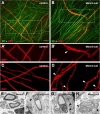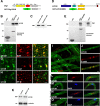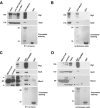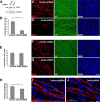Dlg1, Sec8, and Mtmr2 regulate membrane homeostasis in Schwann cell myelination
- PMID: 19587293
- PMCID: PMC6664895
- DOI: 10.1523/JNEUROSCI.1423-09.2009
Dlg1, Sec8, and Mtmr2 regulate membrane homeostasis in Schwann cell myelination
Abstract
How membrane biosynthesis and homeostasis is achieved in myelinating glia is mostly unknown. We previously reported that loss of myotubularin-related protein 2 (MTMR2) provokes autosomal recessive demyelinating Charcot-Marie-Tooth type 4B1 neuropathy, characterized by excessive redundant myelin, also known as myelin outfoldings. We generated a Mtmr2-null mouse that models the human neuropathy. We also found that, in Schwann cells, Mtmr2 interacts with Discs large 1 (Dlg1), a scaffold involved in polarized trafficking and membrane addition, whose localization in Mtmr2-null nerves is altered. We here report that, in Schwann cells, Dlg1 also interacts with kinesin 13B (kif13B) and Sec8, which are involved in vesicle transport and membrane tethering in polarized cells, respectively. Taking advantage of the Mtmr2-null mouse as a model of impaired membrane formation, we provide here the first evidence for a machinery that titrates membrane formation during myelination. We established Schwann cell/DRG neuron cocultures from Mtmr2-null mice, in which myelin outfoldings were reproduced and almost completely rescued by Mtmr2 replacement. By exploiting this in vitro model, we propose a mechanism whereby kif13B kinesin transports Dlg1 to sites of membrane remodeling where it coordinates a homeostatic control of myelination. The interaction of Dlg1 with the Sec8 exocyst component promotes membrane addition, whereas with Mtmr2, negatively regulates membrane formation. Myelin outfoldings thus arise as a consequence of the loss of negative control on the amount of membrane, which is produced during myelination.
Figures









Similar articles
-
Disruption of Mtmr2 produces CMT4B1-like neuropathy with myelin outfolding and impaired spermatogenesis.J Cell Biol. 2004 Nov 22;167(4):711-21. doi: 10.1083/jcb.200407010. J Cell Biol. 2004. PMID: 15557122 Free PMC article.
-
Loss of Mtmr2 phosphatase in Schwann cells but not in motor neurons causes Charcot-Marie-Tooth type 4B1 neuropathy with myelin outfoldings.J Neurosci. 2005 Sep 14;25(37):8567-77. doi: 10.1523/JNEUROSCI.2493-05.2005. J Neurosci. 2005. PMID: 16162938 Free PMC article.
-
Genetic interaction between MTMR2 and FIG4 phospholipid phosphatases involved in Charcot-Marie-Tooth neuropathies.PLoS Genet. 2011 Oct;7(10):e1002319. doi: 10.1371/journal.pgen.1002319. Epub 2011 Oct 20. PLoS Genet. 2011. PMID: 22028665 Free PMC article.
-
Myotubularin-related (MTMR) phospholipid phosphatase proteins in the peripheral nervous system.Mol Neurobiol. 2007 Jun;35(3):308-16. doi: 10.1007/s12035-007-0031-0. Mol Neurobiol. 2007. PMID: 17917119 Review.
-
Charcot-Marie-Tooth type 4B demyelinating neuropathy: deciphering the role of MTMR phosphatases.Expert Rev Mol Med. 2007 Sep 20;9(25):1-16. doi: 10.1017/S1462399407000439. Expert Rev Mol Med. 2007. PMID: 17880751 Review.
Cited by
-
Genetic disruption of Pten in a novel mouse model of tomaculous neuropathy.EMBO Mol Med. 2012 Jun;4(6):486-99. doi: 10.1002/emmm.201200227. Epub 2012 Apr 4. EMBO Mol Med. 2012. PMID: 22488882 Free PMC article.
-
Barrier mechanisms in the Drosophila blood-brain barrier.Front Neurosci. 2014 Dec 16;8:414. doi: 10.3389/fnins.2014.00414. eCollection 2014. Front Neurosci. 2014. PMID: 25565944 Free PMC article. Review.
-
An In Vitro Model of Charcot-Marie-Tooth Disease Type 4B2 Provides Insight Into the Roles of MTMR13 and MTMR2 in Schwann Cell Myelination.ASN Neuro. 2018 Jan-Dec;10:1759091418803282. doi: 10.1177/1759091418803282. ASN Neuro. 2018. PMID: 30419760 Free PMC article.
-
Ral GTPases in Schwann cells promote radial axonal sorting in the peripheral nervous system.J Cell Biol. 2019 Jul 1;218(7):2350-2369. doi: 10.1083/jcb.201811150. Epub 2019 Jun 14. J Cell Biol. 2019. PMID: 31201267 Free PMC article.
-
Imbalance of NRG1-ERBB2/3 signalling underlies altered myelination in Charcot-Marie-Tooth disease 4H.Brain. 2023 May 2;146(5):1844-1858. doi: 10.1093/brain/awac402. Brain. 2023. PMID: 36314052 Free PMC article.
References
-
- Anitei M, Ifrim M, Ewart MA, Cowan AE, Carson JH, Bansal R, Pfeiffer SE. A role for Sec8 in oligodendrocyte morphological differentiation. J Cell Sci. 2006;119:807–818. - PubMed
-
- Asaba N, Hanada T, Takeuchi A, Chishti AH. Direct interaction with a kinesin-related motor mediates transport of mammalian discs large tumor suppressor homologue in epithelial cells. J Biol Chem. 2003;278:8395–8400. - PubMed
-
- Bolino A, Muglia M, Conforti FL, LeGuern E, Salih MA, Georgiou DM, Christodoulou K, Hausmanowa-Petrusewicz I, Mandich P, Schenone A, Gambardella A, Bono F, Quattrone A, Devoto M, Monaco AP. Charcot-Marie-Tooth type 4B is caused by mutations in the gene encoding myotubularin-related protein-2. Nat Genet. 2000;25:17–19. - PubMed
Publication types
MeSH terms
Substances
Grants and funding
LinkOut - more resources
Full Text Sources
Other Literature Sources
Molecular Biology Databases
